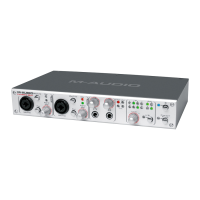correct active spdif input (coaxial or optical) in the Control Panel’s hardware page.
Refer to the hardware page description above.
Setting the Sample Rate
In most cases, you will want to set the sample rate from within your audio software.
When the sync source in the hardware page of the FireWire 1814’s Control Panel is
set to internal, it will receive the sample rate from your audio application. However, if
you are recording a digital source via the optical or coaxial digital inputs, you will want to
set the sync source accordingly. This will allow the incoming digital source to control
the sample rate. This is covered in more detail in the “Hardware Page” section, and in
“Setting Up Your Record Levels.”
Adding Effects While Direct Monitoring
The following section applies when using 44.1kHz and 48kHz sample rates (the aux
send feature is not available at higher sample rates).
This feature sets the FireWire 1814 apart from many other audio interfaces. Direct
monitoring is a way of avoiding the latency inherent in through-the-program monitoring,
especially when building up a large number of tracks (where increasing buffer size and
latency may become necessary). The aux sends in the FireWire 1814 Control Panel
allow you to add effects to the directly monitored signal.
For this example, you must have an outboard effects unit with a S/PDIF digital input and
output (fairly common on the market today). The following step-by-step instructions give you
a basic setup, and then continue on to an advanced setup for adding and monitoring effects.
NOTE: In this example, we would set the sync source selection in the Control Panel’s
hardware page to internal – digital inputs unmuted. The outboard effects unit will get
its clock from the FireWire 1814’s coaxial S/PDIF Out, and therefore will lock to the
FireWire 1814’s internal clock. When the effect unit returns to the S/PDIF input, the
S/PDIF input should be in sync with the internal clock.
1. Connect the FireWire 1814’s S/PDIF out to the S/PDIF input of your outboard
effects unit. In the FireWire 1814’s output page, click on the spdif out channel’s
main/aux switch so that it displays aux.
2. Since we’re going to be monitoring the effect from the S/PDIF input, we must
assign the spdif in channel in the FireWire 1814 mixer page to a destination. Select
the output routing button 1/2 as the destination, so that the effect is mixed in with
other signals being monitored.
3. Set up your FireWire 1814 to record with the analog inputs using the instructions
under the “Setting Up Your Record Levels” section.
4. Let’s assume that you are only using analog Line In 1 for recording (maybe a bass
synth on channel 1). After you have set up a reasonable monitor level using the
level fader on the mixer page’s analog 1 in channel and panned the channel (most
likely center), add some level to the aux L control. That signal is being sent to the
aux output master channel, and then to the spdif out. Since we’re adding an effect

